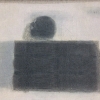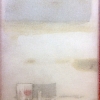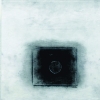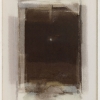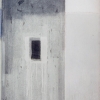Gianriccardo Piccoli

“Lentamente, l’immagine affiora a una superficie che è individuata come suo unico traguardo. In Piccoli pittura e disegno si saldano in un’unità non programmaticamente cercata, ma infine spontaneamente raggiunta.”
Fabrizio D’Amico, da Gianriccardo Piccoli tra flagranza e memoria, 2007, Galleria dello Scudo
Biografia
Gianriccardo Piccoli (Milano, 1941) si è formato all’Accademia di Brera, sotto la guida di Pompeo Borra. La sua prima personale (1963), dedicata ai disegni, si inserisce nel clima della figurazione esistenziale. Nel corso degli anni settanta approfondisce l’indagine sugli interni e sul paesaggio, temi e soggetti che resteranno ricorrenti nella sua produzione successiva. Nel decennio a venire si registra il riconoscimento pubblico del suo lavoro, attraverso il premio Feltrinelli nel 1984, la mostra personale al Teatro Sociale di Bergamo e la partecipazione alla Biennale di Venezia nel 1986. Le due rassegne antologiche nel 1990 - a Tenero (in Svizzera, presso la Galleria Matasci) e a Monza (Musei Civici al Serrone di Villa Reale) - sono l’occasione per trarre il bilancio di un’attività quasi trentennale. Nel 1992 espone in Germania, a Wiesbaden e a Düsseldorf. Nella Chiesa di Sant’Agostino a Bergamo sono esibite, nel 1995, le 14 tele e garze dedicate alle stazioni della Via Crucis. Due anni dopo nella città di Bologna sono organizzate, in ontemporanea, due esposizioni monografiche: la prima dedicata alle Porte (Galleria Otto), la seconda alle carte e alle incisioni (Stamparte). A partire dal 2003 si trasferisce per lunghi periodi di soggiorno a Basilea, dove occupa una casa-studio in Klybeckstrasse, soggetto di una mostra alla Galerie Carzaniga (2004). D’ora in poi vengono varati nuovi materiali (cera vergine, filo di ferro, rame) sempre inseriti in orchestrazioni pittoriche che riassumono i temi di una vita. Nel corso del 2007 la Galleria dello Scudo di Verona organizza una mostra monografica sulla sua opera recente (2001-2007) e il Museo Adriano Bernareggi di Bergamo lo invita a inaugurare un nuovo spazio dedicato all’arte contemporanea (l’ex Oratorio di San Lupo). Nel 2009 Villa Panza a Varese ha organizzato una sua mostra personale, intitolata “Stanze per Villa Panza”. Nel 2010 ha esposto a Roma, presso l’Arciconfraternita dei Bergamaschi, un “Omaggio a Caravaggio”. Nel 2011 è stata inaugurata una chiesa a Portovejo (in Ecuador) con una sua opera intitolata Pentecostes. Alla fine del 2011 è stata pubblicata da Electa una monografia che raccoglie il suo intero percorso figurativo.
—
Biography
Gianriccardo Piccoli, born in Milan in 1941, trained at the Academy of Brera under the guidance of Pompeo Borra and obtained a diploma in 1964. In this same year he began to live in Sarnico, on the Bergamo side of Lake Iseo. His first one-man exhibition, dedicated to drawings, took place during the years of “existential figuration” (1963, Milan, Galleria Celiberti).
In his 1966 exhibition, at the Permanente, Milan, he offered an original interpretation of Lombard informal painting, placing at the centre of his reflections the object which “however much it may be dissolved and lacerated, never abandoned its own presence, was never con- tent to leave just a shadow or traces, but remained like a heart beating inside the painting. And it remained thereafter like something inalienable, a preliminary assumption, almost like a pledge of reality” (Roberto Tassi, 1974). The three years from 1967 to 1969 were years of crisis and experimentation. During this period Piccoli attempted a sort of organic abstraction reminiscent of Graham Sutherland and the photography of Man Ray. This phase was short-lived and has not significantly influenced his artistic outlook. He overcame the crisis of 1968 through a single-minded re-examination of his Lombard roots. The example provided by Ennio Morlotti played a significant role at this stage.
During the 1970s, Piccoli deepened his investigation of everyday objects and of the landscape, themes and subjects that were to recur during his later production. Particularly important, in this phase, were the exhibitions of 1972 at San Se- condo Parmense, of 1974 at the Galleria Mosaico of Chiasso and, also in 1974, at the Galleria Correggio of Parma.
Public recognition of Piccoli’s work grew
over the next decade, with the Premio Feltrinelli in 1984, the one-man exhibition at the Teatro Sociale of Bergamo and his participation in the Venice Biennial of 1986. He also exhibited in the public spaces of Wiesbaden in 1988 (Brunnenkolonnaden am Kurhaus) and held two retrospective exhibitions in 1990, at Tenero (in Switzerland, at the Galleria Matasci) and in Monza (at the Civic museums at the Serrone di Villa Reale).
In the exhibition in Bergamo, the city where he had lived since 1968, he exhibited works of large dimensions in which the intimate subjects achieve lyrical heights through their restrained gestures. His works were now characterized by a grandeur that conferred on them a new visionary and dramatic dimension, where the principal role is played by light. The vast retrospective at Tenero (where works were shown dating from 1964 to 1990) revealed, in his most recent work, the dramatic aspect of his production, as in the dark, bituminous series freely inspired by Arnold Böcklin. This exhibition provided an opportunity to draw some preliminary conclusions on an activity that had by then covered almost thirty years, characterized by an illuminating declaration by the artist: “I have always considered myself a figurative painter, and for a simple but fundamental reason: I can’t conceive – and still less paint – except in figurative terms, that is to say with a strong physical sensation of our corporeal presence on the earth. In this sense I feel that all my forms, even apparently informal ones, have a logical figurative interpretation”.
At the exhibition at Villa Reale, Monza, Piccoli’s works expanded still further, creating a dialogue with the historical rooms of the palace. The colour range became lighter and he embarked on new
experiments with gauze, paper and collages (the monumental Trittico del centro, the hub of the exhibition, was later placed in the original offices of the BPU of Bergamo).
Independent drawings are a constant in Piccoli’s work. Examples are the exhibition curated by Mario De Micheli for the Galleria delle Ore, Milan (1983) and the broad selection gathered into a volume by Stefano Crespi (1962-1987). Definitely influential on Piccoli’s painting was a trip to the United States in 1984 and his reflections on certain episodes from the past, from the Lombard 17th century to Arnold Böcklin’s imagery. The drawings that followed in these years constitute a fine testimony to this interest, which was to assume a central role in his work during the 1990s.
The one-man exhibition in Basle in 1991, organized by the Galleria Carzaniga + Ueker, resulted in a lasting friendship with Arnaldo Carzaniga. It also announced in no uncertain terms a new direction in technical experimentation, research on materials – with abundant use of gauze and of acetates – and study of light. Piccoli now created large-scale paintings by superimposing gauzes and acetates on the canvas. He also used industrial paints, alongside the more traditional oils and tempera, giving birth to images of great visual impact, but also of unexpected lightness.
He was by now a regular presence at the major European art fairs (Basle, Bologna, Cologne). He held one-man exhibitions in Parma (1993, Galleria Sanseverina), Milan (1994, Studio Reggiani), Düsseldorf (in which city he lived and worked during 1995, during the exhibition at the Galerie Winkelmann). His research into light gradually gained intensity during the 1990s, as lucidly described by the artist
himself: “Light has always been a fundamental element in my work: from the natural transparency of pastel interiors to the X-ray-style diversification of the thicknesses of the materials in my diptychs. It has guided my painting right up to the exclusive orchestration of my most recent canvases: a rethinking of light in the classical sense as an absolute value of immateriality”.
In 1995, the 14 canvases and gauzes dedicated to the Stations of the Cross were exhibited in the Church of Sant’Agostino in Bergamo, curated by Mario Botta. Two years later, two monographic exhibitions were mounted contemporaneously in Bologna. The first was dedicated to Porte (Doors) (Galleria Otto), the second to prints and engravings (Stamparte). Themes and content entwined in these two Bologna exhibitions ranging from intimate reflections on recycled materials (re- presented by “doors and windows of the memory”) to themes of civil commitment in Bersagli (Targets), which echoed the Balkan tragedy close at hand.
The experience gained with the Doors cycle was shared with the patients of the Fondazione Emilia Bosis of Bergamo (an institution dedicated to the treatment of pathologies linked to mental illness) through intense laboratory work. The result of this collaboration was exhibited for the first time at the Teatro Sociale of Bergamo in 1997 and, later (on the theme of the Stations of the Cross), at an exhibition in Venice mounted in 1999 in the Church of Santo Stefano.
The Diocese of Bergamo commissioned a monumental work from Piccoli for the Jubilee in 2000, exhibited during that year in the Cathedral of Sant’Alessandro. Beginning in 2003, Piccoli stayed for long periods in Basle, where he occupied a house-studio in Klybeckstrasse,
the subject of an exhibition at the Galerie Carzaniga (2004). New materials were tried, such as beeswax, wire or copper, always forming part of pictorial combinations that summed up the themes of his life’s work: “I try to recompose everything in a fragile drama of light, soaking the gauze in natural wax and leaving parts of the canvas open to evoke memories”. During 2007 the Galleria dello Scudo of Verona organized a monographic exhibition of Piccoli’s most recent work (2001- 2007) and the Museo Adriano Bernareggi of Bergamo invited him to inaugurate a new space dedicated to contemporary art (the ex-Oratory of San Lupo). On this occasion, the artist took inspiration from the Book of Ecclesiastes to create a work specifically conceived for the spatial environment in which it was to be located. In 2009 the Villa and Collezione Panza of Varese mounted a one-man exhibition dedicated to Piccoli (Stanze per Villa Panza).
In 2010 the artist undertook a project in Roma and at Caravaggio, entitled 1610 Roma 2010. Omaggio a Caravaggio. For this occasion he created paintings of large format inspired by subjects and inventions of Caravaggio. In that same year he made a significant number of D’après, taken from the old masters, exhibiting them in Basle (Galerie Carza- niga). In the same spirit he organized, the following year, Il tempo ritrovato (Bergamo, Palazzo Credito Bergamasco).
In 2011 he worked at Portoviejo, Ecuador, where he created a monumental Pentecostés.
Closely linked to the current project is Libro di Spese Diverse di Lorenzo Lotto, a monographic exhibition mounted in 2013 (Basle, Galerie C).
In 2012 he started the collaboration with Galleria Stefano Forni of Bologna that organized a personal exhibition Tracce da un filo in 2014 and promoted him in Italian and international art fairs.
Opere/Artworks
Catalogo della mostra

Gianriccardo Piccoli
Inside. Tracce da un filo, 2023 - pp. 32
Testo di Sandro Parmiggiani
prezzo € 8,00
